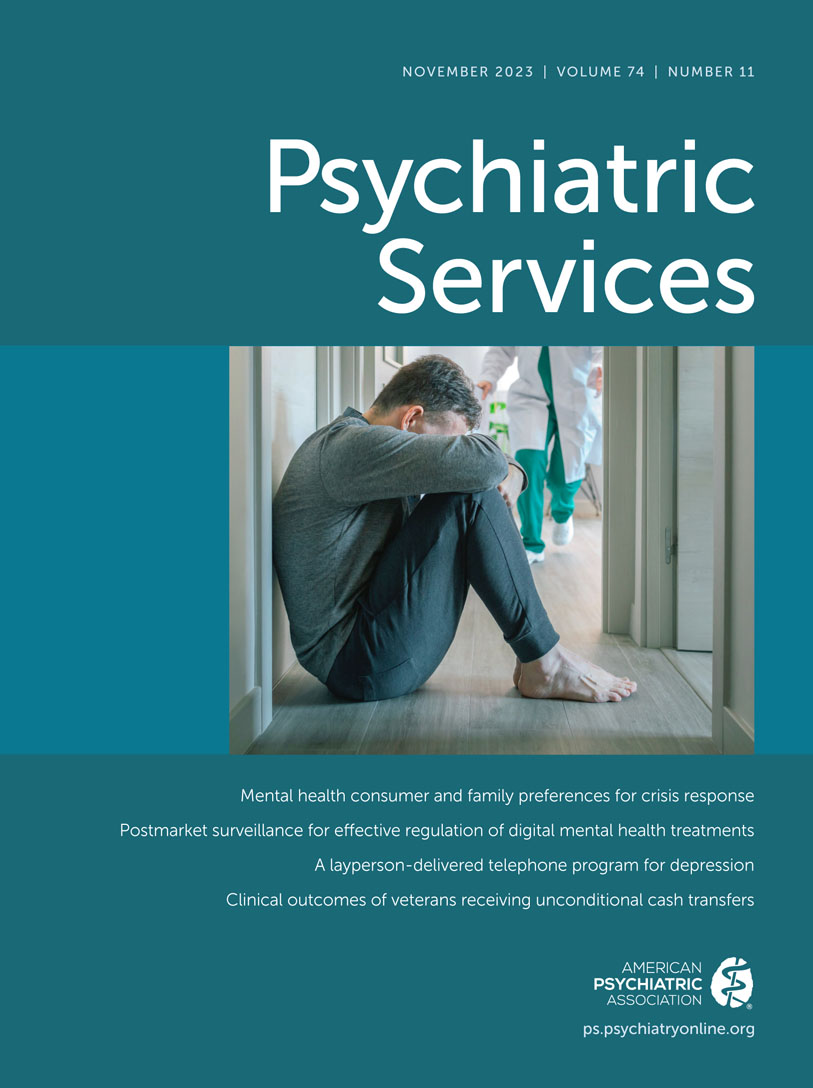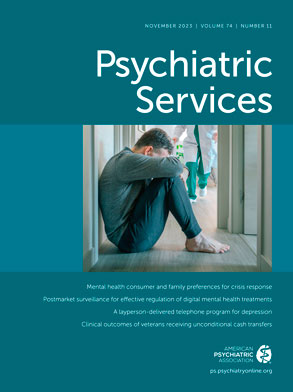Obsessive-compulsive disorder (OCD) is characterized by recurrent intrusive and distressing thoughts, impulses, or images (obsessions) and repetitive behaviors or mental acts (compulsions), often performed to reduce distress caused by obsessions, as defined by the
DSM-5. With a nationally representative sample from the United States, the National Comorbidity Survey Replication study (
1) revealed that OCD has a lifetime prevalence of 2.3% and a 12-month prevalence of 1.2%, with half of affected individuals experiencing onset by age 19. Without treatment, OCD can run a chronic, unremitting course (
2), with reduced quality of life and high levels of social and occupational impairment (
1). Evidence-based treatments exist, including pharmacotherapy with serotonin reuptake inhibitors (SRIs) and cognitive-behavioral therapy (CBT) consisting of exposure and response prevention (EX-RP) (
3). Randomized controlled trials have shown that, alone or in combination, SRIs and EX-RP can help up to half of individuals with OCD achieve minimal symptoms (
4). Little is known about the prevalence or treatment of diagnosed OCD in public behavioral health systems in the United States.
Only one study has addressed the prevalence of OCD among adults in a public health system. In a 9-year (1997–2006) retrospective claims analysis of 2.9 million individuals enrolled in Florida Medicaid, 0.1% were diagnosed as having OCD. Moreover, approximately one-third of those diagnosed as having OCD received a “minimally effective” medication trial—that is, filling two consecutive 30-day prescriptions (implying 8 weeks of treatment) at a “minimum effective dose”—within the first year following diagnosis (
5). That study was limited because it focused only on adults and treatment with medication.
To advance knowledge about the prevalence and treatment of diagnosed OCD in public behavioral health systems, this study assessed annual prevalence and treatment of diagnosed OCD among children and adults receiving behavioral health services in 2019 through New York State (NYS) Medicaid. We examined the prevalence of OCD among children and adults; reported on their demographic, clinical, and Medicaid program characteristics; and compared their characteristics with those of children and adults with other psychiatric disorders in this Medicaid population. We also examined whether children and adults diagnosed as having OCD received treatment with medication or psychotherapy.
Methods
In this study, we used paid 2019 NYS Medicaid claims captured on computerized records, which contained the following information: patients’ demographic characteristics and diagnoses (per
ICD-10), Medicaid program characteristics (type of aid received [Social Security Disability Insurance; SSDI] and service setting [nonbehavioral and behavioral health outpatient services, psychiatric emergency room, psychiatric inpatient unit]), treatment with medications (via national drug codes, drug names, and service units) (
6), and information about psychotherapy (summarized procedures via CPT codes for psychiatric and general medical conditions) (
7). Information about patients was deidentified and fully compliant with the Health Insurance Portability and Accountability Act of 1996 privacy rule (
8). This study was approved by the Nathan Kline Institute Institutional Review Board and was conducted between January 2021 and June 2022.
Demographic characteristics included age, sex, race, and ethnicity. We categorized psychiatric diagnoses hierarchically by using ICD-10 codes (see the online supplement to this report). Claims that included an OCD diagnosis in any service visit in 2019, regardless of comorbid condition, were characterized as an OCD diagnosis. For children, we compared claims with an OCD diagnosis with claims with any anxiety diagnosis excluding OCD; any depression diagnosis excluding OCD and anxiety; and all other psychiatric diagnoses excluding OCD, anxiety, and depression. For adults, we compared claims with an OCD diagnosis with claims with any anxiety diagnosis excluding OCD; any depression diagnosis excluding OCD and anxiety; any psychosis diagnosis excluding OCD, anxiety, and depression; and all other psychiatric diagnoses excluding OCD, anxiety, psychosis, and depression. Other diagnoses examined included comorbid substance use disorders and general medical conditions.
For both children and adults diagnosed as having OCD, evidence-based treatment includes SRI medications (i.e., clomipramine and selective SRIs) or CBT consisting of EX-RP (
4,
9). We assessed type of psychotropic medication, distinguishing SRIs (the class of medications that are approved by the U.S. Food and Drug Administration [FDA] to treat OCD) from other classes of medications that are not FDA approved to treat OCD. We assessed psychotherapy by using CPT codes 90832 (30 minutes); 90834 (45 minutes); 90837 (60 minutes); 90853 (group psychotherapy); and 90846, 90847, and 90849 (family psychotherapy) (
7). Because no available CPT code is specifically designated for CBT treatment, we used length of psychotherapy session (45 or 60 minutes) as a proxy for CBT with EX-RP. Although a 45- or 60-minute psychotherapy session is not likely to include EX-RP, these session lengths provide the best-case scenario for any kind of evidence-based psychosocial treatment for OCD.
Descriptive statistics were used to summarize demographic, clinical, and Medicaid program characteristics of children and adults diagnosed as having OCD. Chi-square tests for independence and analysis of variance were conducted to examine whether the demographic, clinical, and Medicaid program characteristics were related to the diagnosis groups (an OCD diagnosis, any anxiety diagnosis, any psychosis diagnosis [adults only], any depression diagnosis, all other psychiatric diagnoses). Post hoc, pairwise chi-square tests with adjustments for multiple comparisons (
10) were conducted to find out which pairs of the four to five diagnosis groups were significantly different. For those patients with a diagnosis of OCD, the numbers of individuals who received SRIs, 45- or 60-minute psychotherapy sessions, or both are presented.
Results
Of the 2,245,084 children and 4,274,100 adults enrolled in NYS Medicaid (2019), 3,673 (0.2%) children and 12,942 (0.3%) adults were diagnosed as having OCD. The characteristics of children and adults diagnosed as having OCD versus those with other psychiatric disorders are presented in the online supplement. The most notable characteristics of those with OCD were that more than half were White (children: N=2,106, 57.3%; adults: N=7,775, 60.1%), and most were non-Hispanic (children: N=3,572, 97.3%; adults: N=12,321, 95.2%). Digestive diseases were the most common general medical conditions among children (N=1,093, 29.8%) and adults (N=6,393, 49.4%) with OCD. More than one-quarter of children (N=1,012, 27.6%) and adults (N=3,756, 29.0%) diagnosed as having OCD were receiving SSDI benefits, which was approximately twice the rate for children and adults with other psychiatric diagnoses, except for adults with any psychosis diagnosis. Post hoc, pairwise tests showed significant differences between children with OCD and those with other psychiatric disorders in sex, race, ethnicity, SSDI benefits, and services received in nonbehavioral health outpatient settings (data not shown). For adults, significant differences between those with OCD and those with other psychiatric disorders were found in race, ethnicity, tobacco dependence, opioid use disorder, general medical conditions (digestive and respiratory diseases, hypertension, diabetes, obesity), and most service setting variables (nonbehavioral health outpatient, psychiatric emergency room, and psychiatric inpatient unit) (data not shown).
Among children diagnosed as having OCD, 22.3% received a combination of an SRI and a 45- or 60-minute psychotherapy session of unknown modality, 17.8% received an SRI alone, 19.4% received a 45- or 60-minute psychotherapy session alone, and 18.4% did not receive any medication or psychotherapy (
Table 1). Among adults with OCD, 16.8% received a combination of an SRI and a 45- or 60-minute psychotherapy session of unknown modality, 20.7% received an SRI alone, 11.0% received a 45- or 60-minute psychotherapy session alone, and 11.1% did not receive any medication or psychotherapy (
Table 1).
Discussion
This study is the first to document the prevalence, characteristics, and treatment of children and adults diagnosed as having OCD and enrolled in Medicaid. The prevalence of OCD in this sample was 0.2% for children and 0.3% for adults. Fewer than half of children (40.0%, N=1,470) and adults (37.5%, N=4,848) were receiving FDA-approved medication for OCD (with or without 45- or 60-minute psychotherapy sessions); another 19.4% of children and 11.0% of adults were receiving 45- or 60-minute psychotherapy alone. Our findings provide further evidence of underdiagnosis and limited use of evidence-based treatment for OCD in public behavioral health systems.
Several characteristics of the sample are worth highlighting. First, White children and adults were overrepresented in the OCD population (children, 57.3%; adults, 60.1%) relative to their representation in the full Medicaid population (children: 29.4%, N=659,567 of 2,245,084; adults: 30.0%, N=1,283,027 of 4,274,100). Barriers to care for OCD among African Americans with OCD have been previously documented (
11). To address this issue, researchers have proposed several strategies, such as conducting outreach efforts in community-based settings (e.g., churches, community centers), using culturally tailored educational materials and screening tools (
11), and facilitating access to clinical settings (e.g., expanding days and hours) that serve underserved populations facing multiple barriers to care.
Second, multiple U.S. studies have documented impairments in occupational functioning among people with OCD or the need for financial support due to disability (
12). Our study contributes to this literature by demonstrating that in this 2019 NYS Medicaid database sample, more than one-quarter of children and adults with OCD were receiving SSDI; these rates are higher compared with those for children and adults with other psychiatric diagnoses, except for adults with any psychosis diagnosis. Together, these data indicate a pressing need for interventions to support individuals with OCD who are not able to work. One starting place would be to test whether supported education and employment interventions that have been found to be effective in treating populations with other serious mental illnesses (e.g., schizophrenia) might also be effective for those with OCD (
13).
Third, in our sample, patients with OCD were not typically receiving evidence-based treatment. Despite the availability of SRI medications, fewer than half of children and adults with an OCD diagnosis were receiving an SRI (with or without a psychotherapy session of at least 45 minutes). This finding highlights the need to educate prescribers about OCD. Moreover, only 19.4% of children and 11.0% of adults were receiving a psychotherapy session of at least 45 minutes. Without specific information about psychotherapy modality, even these very low rates of use overestimate the use of EX-RP, the first-line treatment for children (
9) and arguably the most effective treatment for OCD (
4). Lack of access to trained EX-RP clinicians may contribute to these low rates of use (
14). Advances in technology and adapted models of EX-RP delivery in behavioral health outpatient settings may be other ways to increase EX-RP reach and access (
15).
Strengths of this study include its use of a full NYS Medicaid claims database, the presentation of data about both children and adults with OCD, and the ability to describe their characteristics and the treatment they received. Several limitations should also be noted. First, our sample was composed of Medicaid enrollees who were insured on the basis of a means test or presence of a disability; therefore, findings cannot be generalized to those with other types of health insurance or those who are uninsured. Second, psychotherapy was not specified by modality or duration, only by session length. Thus, whether EX-RP (or even CBT) was delivered is unknown; moreover, the very low rates of psychotherapy use suggest significant underutilization of EX-RP, an important first-line treatment for OCD, further highlighting the problem of underutilization of first-line psychotherapy treatment. Finally, claims data rely on clinicians’ diagnosis and treatment coding procedures, which may vary in accuracy.
Conclusions
In summary, these data reveal underdiagnosis and limited use of evidence-based treatment among adults and children with OCD as well as potential racial disparities in the diagnosis of OCD. Data from state systems of care can inform workforce development focused on training frontline clinicians in the identification and treatment of OCD (
14). In future studies, researchers should also examine whether the disparities in identification and treatment of OCD documented in these data have been exacerbated by the COVID-19 pandemic.

